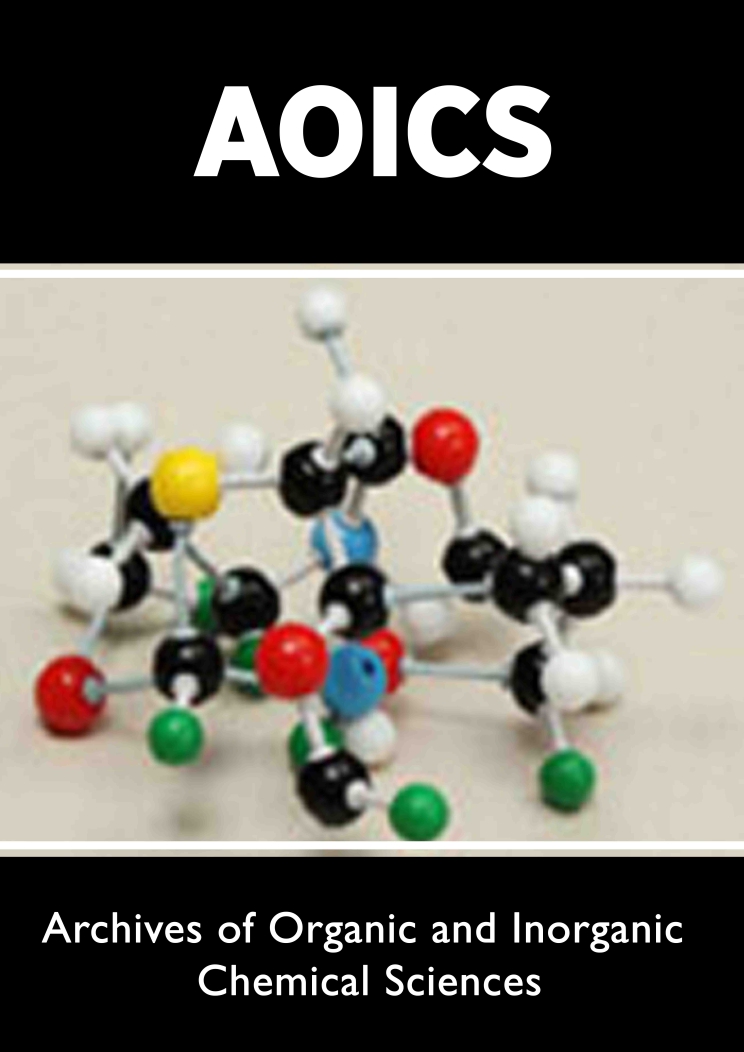
Lupine Publishers Group
Lupine Publishers
Menu
ISSN: 2637-4609
Research Article(ISSN: 2637-4609) 
Formation of Single Phased Mixed Crystals from Aqueous Solutions - an Overview Volume 4 - Issue 3
CK Mahadevan*
- Department of Physics, Bharathidasan University, Tiruchirappalli-620024, Tamil Nadu, India
Received: February 03, 2020; Published: February 13, 2020
*Corresponding author: CK Mahadevan, Department of Physics, Bharathidasan University, Tiruchirappalli-620024, Tamil Nadu, India, E-mail: mahadevan58@yahoo.co.in
DOI: 10.32474/AOICS.2020.04.000187
Abstract
Single phased mixed crystals are normally formed from two or more isomorphous end member crystals with some conditions. However, in some circumstances, it is possible that such mixed crystals can be formed/prepared/grown from aqueous solutions even when the end member crystals are not isomorphous with each other. An overview of various studies made in this direction is presented in this article focusing the results reported by the present author’s research group.
Keywords: Aqueous solutions; Crystal growth from solution; Mixed crystals; Quasi mixed crystals; Solid solutions
Introduction
Single crystals are solids with regular (three dimensionally
periodic) arrangement of the constituent atoms, ions or molecules
into some fixed and rigid pattern known as a lattice. So, formation/
preparation/growth of single crystals means careful arrangement
of atoms, ions or molecules in a particular three-dimensional order.
There are four major categories of crystal growth methods, viz.
solid-state growth, vapor growth, melt growth and solution growth.
Solution and melt growth methods are treated separately because
solution growth methods differ from methods used for pure melt
growth. Crystal growth from solution, an ancient as well as a more
advantageous method, is classified into two, viz. low temperature
solution growth and high temperature solution growth. If suitable
solvents are available, low temperature solution growth can very
well be used for the crystal growth of materials which decompose
on heating and/or which exhibit any structural transformation
while cooling from the melting point. The required super
saturation may be obtained by evaporation of solvent by cooling
the solution or by a transport process in which the solute is made
to flow from a hotter to a cooler region. Evaporation is permissible
into the atmosphere for non-toxic solvents such as water. Photonic
and dielectric crystals are mainly grown by adopting the melt and
solution (mostly aqueous) methods.
It is a known fact that naturally occurring crystals are scarce
or imperfect or having less tunable properties and nature’s
enormous laboratory is unable to meet the demands of developing
technology. Also, it is known that there are several factories
available where various crystals ranging in size from small to large
crystals are grown. However, further research in the preparation
and characterization of crystalline materials and growth of large
size crystals is very much necessary for our social requirements.
The most important question now is: How to tune or stimulate the
physical (optical, mechanical, electrical, magnetic, etc.) properties
of crystals? For many applications, it is required to control and
alter the functionalities and properties of crystalline materials
with greater flexibility and possibility. The most important
approach in this regard is to form hybrid material crystals that
have properties different from that of single component material
crystals. In order to meet the increasing demand of new materials
with good optical and electrical properties, formation of new
hybrid (doped and/or mixed) crystals has become an interesting
and important investigation in crystal growth. A single phased
mixed crystal is normally formed by crystallizing together two or
more isomorphous crystals with comparable lattice volumes. If the
end member crystals are not isomorphous with each other, it is
expected to form multi phased mixed crystals. However, in certain
circumstances, it is possible for us to form single phased mixed
crystals even if the end member crystals are not isomorphous with
each other. In this article (a brief overview), we consider mainly the
conditions for the formation of single phased mixed crystals from
aqueous solutions focusing the results reported by the present
author’s research group.
Mixed Crystals
On forming a mixed crystal, the added (guest or solute) ion goes to substitutional position or interstitial position which is determined by the ionic radius of the added ion and electronic configuration of the lattice (host or solvent) ion. Three different kinds of mixed crystals (solid solutions) can be grown (or formed/ prepared), viz. substitutional, interstitial and defect solid solutions [1]. In the case of substitutional solid solutions, some of the normal lattice sites in the solvent crystal are occupied by the solute atoms without changing the structure of the solvent crystal. In interstitial solid solutions, the solute atoms occupy the interstitial positions of the solvent crystal without changing its structure. Some sites in the lattice of one component remain vacant in the case of defect solid solutions. A mixed crystal (single/multi phased) may have its physical properties analogous to those of the end member (pure) crystals. The mixed crystal composition varies from system to system and the properties may change in a linear or nearly linear manner. For several properties, the composition dependence is highly nonlinear and, in some cases, the magnitude of the property for the mixed crystal even exceeds that for the end member crystals. So, once the trend in mixed crystal composition dependence is established, we have tailor-made new crystals for our use with desired values for the given properties.
Single Phased Mixed Crystals
Tobolsky’s rule states that, for ionic crystals like alkali halides, complete miscibility is possible only above a temperature T K given by T = 4.5δ2, δ being the percentage difference in lattice constants [2,3]. Here, δ takes a value of 6% for alkali halides at room temperature. It can be understood that there are available broad miscibility gaps in several binary and ternary systems of alkali halides at room temperature. So, for these systems, single phased mixed crystals are not possible to be prepared by the low temperature solution methods even when these alkali halides have considerable solubility in water. A study made by Mahadevan and his co-workers [4] with (NaCl)x(KCl)0.9-x(KBr)0.1 solutions evidenced the above. Anandakumari and Chandramani [5] reported that they had grown single phased (KBr)x(NaBr)1-x single crystals at room temperature from aqueous solutions. As per Tobolsky’s rule, the miscibility is possible for this system at above 488 K. Later, Padma and Mahadevan [6] inferred that the single crystals grown by Anandakumari and Chandramani ought to be multi phased and they would have reported only the total average values of the lattice constants. Moreover, Mahadevan and his co-workers [6-12] have evidenced Tobolsky’s rule with alkali halide mixed crystals (both single and poly crystals) grown from melts. In addition, Barrett and Wallace [13] have reported that NaxK1-xCl system does not form a continuous series of single phased mixed crystals. Also, Nair and Walker [14] have reported that for the extreme concentration ranges x < 0.3 and x > 0.7 the KBr1-xIx crystals could be characterized by single f.c.c. lattice constants, while in the intermediate region three f.c.c. phases characterized by three lattice constants.
It is also interesting to note that Padma and Mahadevan [15] could obtain multi phased mixed poly crystals (NaCl-KBr, NaCl- KBr-KCl and NaCl-KBr-NaBr) grown from miscible NaBr and KCl. Priya and Mahadevan [16] could obtain multi phased ternary and quaternary mixed poly crystals (NaCl-KCl-KBr, NaCl-NaBr-KBr and NaCl-NaBr-KCl-KBr) grown from miscible NaBr, KCl and KBr. It should also be understood that Na+ has more affinity towards Clthan Br-. In general, the formation of single phased mixed crystal requires that [17,18]:
a) The structures of the two crystals should be of similar
type.
b) The bonds in the two crystals should be of similar type.
c) The radii of the substituent atoms should not differ by
more than about 15 % from that of the smaller one.
d) The difference between their lattice parameters should be less than 6 %. It is a known fact that potassium di-hydrogen orthophosphate (KDP, KH2PO4) and ammonium di-hydrogen orthophosphate (ADP, NH4H2PO4) are hydrogen bonded and nonlinear optically important crystals.
Both KDP and ADP belong to the tetragonal crystal system and are isomorphous with each other. They have the tetra-molecular unit cell dimensions as: a=b=7.448 and c= 6.977 Å for KDP [19]; and a= b=7.510 and c = 7.564 Å for ADP [19]. It is possible that single phased mixed crystals of KDP with ADP can be prepared as per the above conditions. Moreover, KDP-ADP mixed crystals are interesting particularly due to modification of the hydrogen bonding system in a certain intermediate mixing composition range which leads to significant change in the properties of the crystals [20]. Although there are some reports available on the growth and characterization of K1-x(NH4) x H2PO4 single crystals [20-25], there exists some challenge in obtaining large size mixed crystals in the intermediate mixing composition range.
Magnesium sulfate heptahydrate (MSH, MgSO4.7H2O, Epsomite), nickel sulfate heptahydrate (NSH, NiSO4.7H2O, Morenosite) and zinc sulfate heptahydrate (ZSH, ZnSO4.7H2O, Goslarite) crystals are isomorphous with each other and crystallize in the orthorhombic crystal system. They have the tetra-molecular unit cell dimensions as: a = 11.86, b = 11.99 and c = 6.858 Å for MSH [19]; a = 11.86, b = 12.08 and c = 6.81 Å for NSH [19]; and a = 11.779, b = 12.050 and c = 6.822 Å for ZSH [26,27]. As these three materials are not only isomorphous with each other but also with comparable lattice constants (or lattice volumes), single phased mixed (both binary and ternary) crystals can easily be grown by the solution method. Mahadevan and his co-workers have already reported the growth and characterization of single phased MgxZn1-x SO4.7H2O [28,29], NixMg1-xSO4.7H2O [30] and NixZn1-xSO4.7H2O [27] crystals. All the above metal sulfate heptahydrate mixed crystals have been grown by the slow (free) evaporation of solvent method from aqueous solutions. The lattice volumes obtained through X-ray diffraction analysis have been found to be nearly additive with the mixed crystal composition and obey the relation:
V = xV1 + (1-x) V2,
Which is similar to Retger’s rule applied to cubic system [26,30]. Here, V is the lattice volume of the mixed crystal and V1 and V2 are the lattice volumes of the end member crystals. L-histidine hydrochloride (LHHCl) and L-histidine hydrobromide (LHHBr) single crystals are found to be isomorphous with each other and are expected to form single phased mixed crystals [31]. Suja Rani et al. [32, 33] have formed LHHCl-LHHBr mixed crystals by the slow evaporation of solvent method by mixing equimolar proportion of L-histidine and acid (HClxBr1-x with x = 0.0, 0.2, 0.3, 0.4, 0.5, 0.6, 0.7, 0.8, 0.9 and 1.0). X-ray diffraction analysis confirmed the formation of single phased mixed crystals belonging to the orthorhombic crystal system with non-centrosymmetric space group of P212121. Here, in the formation of end member and mixed crystals, a reaction takes place and the product is crystallized. The acid molecules used (HCl and HBr) are isomorphous with each other. That is, molecular isomorphism is present in the reaction. Now, a question arises. When the end member crystals are not strictly isomorphous with each other, can we use the molecular isomorphism of the reactants to form single phased mixed crystals? It has been found that it is possible in the cases of both anionic and cationic substitutions. Moreover, quasi mixed crystals can also be formed in a similar way.
Mixed Crystals with Non-isomorphous End Members
Bis(thiourea)cadmium chloride (BTCC) is a semi-organic NLO crystal with lattice parameters: a = 5.812, b = 6.485 and c = 13.106 Å; V = 493 Å3 [17,34]. Bis(thiourea)cadmium iodide (BTCI) is a similar metal complex crystal (with chloride replaced by iodide) with lattice parameters: a = 10.520, b = 7.600 and c = 15.086 Å, β = 91.14 o; V = 1206 Å3 [17,35]. The BTCC and BTCI crystals belong to orthorhombic and monoclinic crystal systems respectively and radii of Cl-1 and I-1 for 6 coordination respectively are 1.81 and 2.20 Å [36] (the difference is > 15 %). Prameela Kumari and Mahadevan [17] have formed the (BTCC)x(BTCI)1-x crystals from the isomorphous precursors directly even though the end member crystals have lattice mismatching. The crystals were grown by the free evaporation of solvent method at room temperature and the mixed crystals with middle compositions (x = 0.6, 0.5 and 0.4) were found to be small in size. The molecular isomorphism of cadmium chloride and cadmium iodide was used (anionic substitution). It has been found that, through X-ray diffraction analysis, (BTCC)x(BTCI)1-x crystals wit x = 1.0, 0.8 and 0.6 are orthorhombic in structure with space group Pma21 and that with x = 0.5, 0.4, 0.2 and 0.0 are monoclinic in structure with space group P21/c. Magnesium tris(thiourea)sulphate (MTS) belongs to the monoclinic crystal system with lattice parameters: a = 7.67, b = 5.48 and c = 8.56 Å, β = 131.1 o [37]. Zinc tris(thiourea)sulphate (ZTS) belongs to the orthorhombic crystal system with lattice parameters: a = 11.130, b = 7.773 and c = 15.490 Å [38]. Darlin Mary et al. [39,40], by using the molecular isomorphism (cationic substitution), have formed the ZTS-MTS mixed crystals by the free evaporation of solvent method at room temperature. The lattice parameters obtained through X-ray diffraction analysis show that the grown pure ZTS and mixed ZTS-MTS crystals belong to the orthorhombic crystal system.
The calcium succinate (CS, CaC4H4O4) and barium succinate (BS, BaC4H4O4) single crystals have been grown and found to have different number of water molecules and different crystal lattices. The BS crystal grown [41] with one water molecule possesses monoclinic crystal structure with lattice parameters: a = 5.20, b = 9.02 and c = 5.60 Å, β = 91.16 o. The CS crystal grown [42] with 2.3 water molecules possesses triclinic crystal structure with lattice parameters: a = 6.636, b = 7.866 and c = 9.420 Å; α = 71.8, β = 89.1 and γ = 68.4 o. Christy et al. [43] have grown, by the free evaporation of solvent method, at room temperature the BaxCa1-xC4H4O4 (x = 0.2, 0.4, 0.5, 0.6 and 0.8) crystals (cationic substitution) using isomorphic precursors (calcium carbonate and barium carbonate). X-ray diffraction analysis indicated that the crystals with x = 0.2, 0.4 and 0.5 contain fractional water molecules whereas crystals with x = 0.6 and 0.8 contain no water molecule. Jesudurai et al. [44] have reported the growth and characterization of mixed crystals (cationic substitution) based on ammonium pentaborate dihydrate (AB5) and potassium pentaborate dihydrate (KB5), (NH4)1-xKxB5O8 crystals. The 2 pure and 6 mixed crystals (single phased) grown by them belong to the orthorhombic crystal system and are found to be isomorphous with each other. The mixed crystals grown are found to have more ammonium content than they considered in the solution. Sodium pentaborate dihydrate (NB5) crystal belongs to the monoclinic crystal system with space group P21/c and lattice parameters: a = 11.114, b = 16.437 and c = 13.580 Å, β = 111.94o [45]. KB5 crystal belongs to the orthorhombic crystal system with space group Aba2 and lattice parameters: a = 11.043, b = 11.177 and c = 9.042 Å [46]. The lattice mismatching between KB5 and NB5 could be due to the difference in their ionic radii (for 8 coordination as oxygen atoms are coordinated to K/Na: 1.18 Å for Na+1 and 1.51 Å for K+1 [36]).
Single crystals of (NB5) x (KB5)1-x (with x = 1.0, 0.8, 0.6, 0.5, 0.4, 0.2 and 0.0) have been grown by the slow evaporation of solvent method using the molecular isomorphism of the precursors. X-ray diffraction analysis indicated the formation of single phased mixed crystals belonging to the orthorhombic crystal system [18,47]. Energy dispersive X-ray absorption and atomic absorption spectroscopic analyses confirmed the presence of Na and K atoms in mixed crystals in proportion with precursors (sodium carbonate and potassium carbonate) taken in solution used for the crystal growth.
Quasi Mixed Crystals
Sodium and potassium hydrogen phthalates (NaHP and KHP) belong to orthorhombic crystal system with non-centrosymmetric space groups B2ab and Pca21 respectively. Ramasamy and Meenakshisundaram [48] have grown the K0.78Nac1.22 [C6H4(COO)2].H2O crystal (NaKP) belonging to the trigonal crystal system with centrosymmetric space group P(-3)1c at room temperature by the slow evaporation of solvent method using KHP and NaOH as the precursors. This NaKP has been found to exhibit high second harmonic generation (SHG) activity (1.14 times that of KHP which could be explained as due to dislocation of NaKP crystal into KHP and NaHP (both NLO-active materials) leading to local non-centrosymmetry.
Amuthambigai et al. [49] have also grown at ambient conditions by the solvent evaporation method good quality bimetallic (Na and K) phthalate single crystals but with a different composition (Na0.51K1.49[C6H4(COO)2].H2O). This crystal also belongs to the trigonal crystal system with space group P(-3)1c exhibiting good SHG activity (0.93 times that of KHP). Another bimetallic phthalate (Li incorporated KHP, C16H16KLiO11) crystal has also been successfully grown from aqueous solution and reported [50]. Zinc cadmium thiocyanate (ZCTC, ZnCd(SCN)4) is a semi-organic highly efficient NLO material. It belongs to the tetragonal crystal system with lattice parameters: a = b = 11.135 and c = 4.376 Å [51]. The –S=C=N- bridges between Cd and Zn atoms in it leads to the formation of an infinite three-dimensional –Cd-S=C=N-Zn- network permitting us to combine the advantages of inorganic crystal with those of organic crystals such as good stability and high nonlinearity [52].
In order to understand the effect of forming hybrid crystals by quasi mixing on the physicochemical properties of the basic material crystal, Latha et al. [53] have attempted to grow, by the free evaporation of solvent method at room temperature, ZnxCd(2-x)(SCN)4 (with x = 0.0, 0.4, 0.8, 1.0, 1.2, 1.6 and 2.0) single crystals. They could grow single crystals with x = 0.0 (leading to Cd(SCN)2) but not when x = 2.0 (leading to Zn(SCN)2). The crystal with x = 1.0 is the normal ZnCd(SCN)4 crystal. X-ray diffraction analysis indicated that the ZnCd(SCN)4 crystallizes in the tetragonal crystal system; ZnxCd(2-x)(SCN)4 with x = 0.0, 0.4 and 0.8 crystallize in the orthorhombic crystal system; and ZnxCd(2-x)(SCN)4 with x = 1.2 and 1.6 crystallize in the hexagonal crystal system. This study indicated a decrease of dielectric constant and SHG efficiency when quasi mixing is done. However, this study has shown the possibility of obtaining a new class of bimetallic thiocyanate single crystals. A3MX5.nH2O (where A is a univalent cation, M is a divalent metal and x is a halogen) crystals are found to exhibit unusual physical properties.
These crystals are normally prepared by mixing AX and MX2.nH2O in 3:1 molecular ratio. However, varying stoichiometries have been found to occur in these mixed compound crystals and, due to that, they exhibit unusual physical properties. Mahadevan and his co-workers [54-56] have prepared, from aqueous solutions by the slow evaporation of solvent method, K3.088Ba0.912Cl4.912.1.369H2 (KBC, from 3KCl+BaCl2.2H2O solution), K3.611Ca0.389Cl4.389.1.177H2O (KCC, from 3KCl+CaCl2.2H2O solution) and Na3.665Ca0.335Cl4.335.0.153H2O (NCC, from 3NaCl+CaCl2.2H2O solution) single crystals and characterized. The temperature dependence of DC electrical conductivity observed by them indicated that KBC is a dielectric material while the others (KCC and NCC) are ionic conductors. Less non-stoichiometry retains the dielectric nature (usual for ionic substances) and higher non-stoichiometry leads to ionic conduction. X-ray diffraction analysis indicated that all the above three crystals belong to the triclinic crystal system with lattice parameters: a = 6.286, b = 6.294 and c = 6.309 Å, α = 90.04, β = 90.03 and γ = 90.30o, V = 249.61 Å3 for KBC; a = 6.267, b = 6.282 and c = 6.319 Å, α = 89.90, β = 90.73 and γ = 90.58 o, V = 248.71 Å3 for KCC; and a = 5.633, b = 5.641 and c = 5.624 Å, α = 90.16, β = 89.93 and γ = 90.56 o, V = 178.71 Å3 for NCC.
Conclusion
The validity of Tobolsky’s rule put forward for ionic crystals like alkali halides and the general conditions put forward in the preparation of single phased mixed crystals has been proved by several reports available in the literature. Also, it has been understood that single phased normal as well as quasi mixed crystals can be prepared from aqueous solutions even when the end member (or mixing) crystals do not obey the general conditions. However, this is found to be possible when the mixed crystals are grown (the product crystallizing in a reaction) by using the molecular isomerism of the precursors involved in the reaction.
Conclusion
The support by the Council of Scientific and Industrial Research, New Delhi, India under the Emeritus Scientist Scheme (CSIR-ES Scheme No.: 21(1083)/19/EMR-II) is hereby gratefully acknowledged.
Funding
This research received no specific grant from any funding agency.
References
- Haldik J (1972) Physics of Electrolytes. Academic Press, India.
- Tobolsky AV (1942) Solid solutions of the alkali halides, J Chem Phys 10: 187-192.
- Li Guo, Weizhao Jin, Zekun Chen, Jinghe Liu, Priya Murugasans, et al. (2017) Large size crystal growth and structural, thermal, optical and electrical properties of KCl1-xBrx mixed crystals. J Cryst Growth 480: 154-163.
- Sahaya Shajan X, Sivaraman K, Mahadevan C, Chandrasekharam D (1992) Lattice variation and stability of NaCl-KCl mixed crystals grown from aqueous solutions. Cryst Res Technol 27(4): K79-K82.
- Anandakumari R, Chandramani R (2003) Evaluation of lattice parameter and defect related studies of (KBr)x(NaBr)1-x mixed crystals grown from aqueous solution. Indian J Phys 77A(3): 219-224.
- Padma CM, Mahadevan CK (2008) Growth and characterization of multiphased mixed crystals of NaBr and KBr. Mater Manuf Processes 23(2): 143-150.
- Perumal S, Mahadevan CK (2005) Growth and characterization of multiphased mixed crystals of KCl, KBr and KI: 1. Growth and X-ray diffraction studies. Physica B 369(1-4): 89-99.
- Jayakumari K, Mahadevan C (2005) Growth and X-ray studies of (NaCl)x(KCl)y-x(KBr)1-y single crystals. J Phys Chem Solids 66(1): 1705-1713.
- Selvarajan G, Mahadevan CK (2006) Studies on (NaCl)x(KBr)y-x(KI)1-y solid solutions: 1. Lattice and thermal parameters. J Mater Sci 41: 8211-8217.
- Neelakanda Pillai N, Mahadevan CK (2007) Preparation and electrical properties of (NaCl)x(NaBr)y-x(NaI)1-y crystals. Mater Manuf Processes 22(3): 393-399.
- Priya M, Mahadevan CK (2008) Preparation and dielectric properties of oxide added NaCl-KCl polycrystals. Physica B 403(1): 67-74.
- Priya M, Mahadevan CK (2009) Studies on multiphased mixed crystals of NaCl, KCl and KI, Cryst Res Technol. 44(1): 92-102.
- Barrett WT, Wallace WE (1954) Studies of NaCl-KCl solid solutions.1. Heats of formation, lattice spacings, densities. Schotky defects and mutual solubilities1,2 J Am Chem Soc 76(2): 366-369.
- Nair IR, Walker CT (1973) Raman scattering and X-ray scattering studies on KBr1-xIx, KCl1-xIx, K1-xRbxCl. Phys Rev 37: 2740-2746.
- Padma CM, Mahadevan CK (2007) On the preparation of multiphased mixed crystals from NaBr and KCl. Mater Manuf Processes 22(3): 362-365.
- Priya M, Mahadevan CK (2008) Formation of multiphased mixed crystals from miscible NaBr, KBr and KCl. Cryst Res Technol 43(10): 1069-1073.
- Prameela Kumari IS, Mahadevan CK (2014) Formation and characterization of mixed crystals based on bis(thiourea)cadmium chloride and bis(thiourea)cadmium iodide. Int J Eng Res Appl (IJERA) 4(7:4): 125-144.
- Benita Jeba Silviya S, Mahadevan CK, Balu T, Moses Ezhil Raj A, Balakumar S, et al. (2018) Urea doped crystals formed with potassium-sodium pentaborate (K0.5Na0.5B5), Surfaces and Interfaces 11: 14-21.
- Mahadevan CK (2019) Impurities and homogeneous crystal nucleation in aqueous solutions-An overview. Mater Sci Res India 16: 198-208.
- Rajalekshmi V, Madhu KU, Mahadevan CK (2016) Electrical properties of pure and glycine added KDP-ADP mixed crystals. Int J Innov Res Sci Eng Technols (IJIRSET) 5(6): 9193-9208.
- Ono Y, T Hikita T , Ikeda T (1987) Phase transitions in mixed crystal system K1-x(NH4)xH2PO4. J Phys Soc Jpn 56: 577-588.
- Vaezzadeh M, Wyncke B, Brehat F (1992) Far-infrared reflectivity spectroscopy of potassium ammonium dihydrogen phosphate mixed crystals. J Phys Condensed Matter 4(36): 7401.
- Xiue Ren, Dongli Xu, Dongbeng Xue (2008) Crystal growth of KDP, ADP, and KADP. J Cryst Growth 310(7-9): 2005-2009.
- Rajaleksmi V, Mahadevan CK (2015) Effect of glycine as an impurity on the structural and optical properties of KDP-ADP mixed crystals. Int J Innov Res Sci Eng Technols (IJIRSET) 4(11): 10957-10970.
- V Rajalekshmi , CK Mahadevan (2016) Thermal and mechanical properties of KDP-ADP mixed crystals added with glycine. Int J Eng Res Technol (IJERT) 5(5): 717-721.
- Dahlia Queen Livingsta A, Mahadevan C (2002) Lattice and thermal parameters of NixZn1-xSO4.7H2O crystals. Indian J Phys 76A: 271-275.
- Kavitha JM, Mahadevan CK (2014) Growth and characterization of NixZn1-xSO4.7H2O single crystals. Spectrochim Acta Part A 128: 342-350.
- Jayakumari K, Mahadevan C (1992) Optical investigations on MgxZn1-xSO4.7H2 J Optics 21: 22-24.
- Jayakumari K, Mahadevan C, Chandrasekharam D (1993) X-ray investigations on MgxZn1-xSO4.7H2O mixed crystals. J Pure Appl Phys 5: 331-334.
- Theivanayagom M, Mahadevan C (2001) Lattice variation and thermal parameters of NixMg1-xSO4.7H2O single crystals. Bull Mater Sci 24(5): 441-444.
- Tanusri Pal, Tanusree Kar, Xin Qiang Wang, Guang Ying Zhou, Dong Wang, et al. (2002) Growth and characterization of nonlinear optical material, LAHClBr-a new member of L-arginine halide family. J Cryst Growth 235(1-4): 523-528.
- Suja Rani J, Mahadevan CK, Antony Arockiaraj M, Rajasekar S, Vimalan M, et al. (2013) Growth and characterization of semiorganic nonlinear optical LHHCl-LHB mixed crystals. Arch Appl Sci Res 5(2): 213-221.
- Suja Rani J, Jayakumari K, Mahadevan CK (2014) Growth and optical, thermal and electrical characterization of LHC-LHB mixed crystals. Int J Eng Res Appl (IJERA) 4(3:1): 741-751.
- Venkataramanan V, Maheswaran S, Sherwood JN, Bhat HL (1997) Crystal growth and physical characterization of the semiorganic bis(thiourea)cadmium chloride. J Cryst Growth 179(3-4): 605-610.
- Lydia Caroline M, Vasudevan S (2009) Growth and characterization of bis(thiourea)cadmium iodide: A semiorganic single crystal, Mater Chem Phys. 113(2-3): 670-674.
- David R Lide (1999) Ionic radii in crystals, CRC Handbook of Chemistry and Physics Eightieth (edn.), CRC Press, New York, USA.
- Pasupathy G, Philominathan P (2009) Crystal growth, thermal, optical and microhardness studies of tris(thiourea)magnesium sulphate. Modern Phys Lett: B. 23(25): 3035-3043.
- Venkataramanan V, Dhanraj G, Wadhawan VK, Sherwood JN, Bhat HL (1995) Crystal growth and defects characterization of zinc tris(thiourea)sulfate: a novel metalorganic nonlinear optical crystal. J Cryst Growth 154(1-2): 92-97.
- Darlin Mary A, Jayakumari K, Mahadevan CK (2013) Growth and characterization of zinc-magnesium tris(thiourea)silphate (ZMTS) single crystals. Int J Eng Res Appl (IJERA) 3(6): 1183-1197.
- Darlin Mary A, Jayakumari K, Mahadevan CK (2014) Electrical measurements on zinc-magnesium tris(thiourea)sulphate (ZMTS) single crystals. Int J Eng Res Technol (IJERT) 3(1): 615-625.
- Christy DS (2019) Synthesis, growth and characterization of some novel semiorganic crystals. Ph.D. Thesis submitted to Anna University, Chennai, India.
- Christy DS, Mahadevan CK, Sahaya Shajan X (2017) Growth by free evaporation method and physico-chemical properties of calcium succinate single crystals. Optik 145: 418-427.
- Christy DS, Mahadevan CK, Sahaya Shajan X (2018) Growth at room temperature and investigation of physicochemical characteristics of new semi-organic BaxCa1-xC4H4O4 (x = 0.2, 0.4, 0.5, 0.6 and 0.8) crystals. Cryst Res Technol 53: 1700109 (16 pages).
- Jesudurai JGM, Prabha K, Dennis Christy P, Madhavan J, Sagayaraj P (2008) Synthesis, growth and characterization of new borate mixed crystals of type (NH4)1-xKxB5O8, Spectrochim. Acta Part A 71(4): 1371-1378.
- Benita Jeba Silviya S, Mahadevan CK, Balu T, Moses Ezhil Raj A, Balakumar S (2017) Growth and physicochemical properties of pure and urea doped sodium pentaborate dihydrate single crystals. Int J ChemTech Res 10(7): 553-562.
- Benita Jeba Silviya S, Mahadevan CK, Balu T, Moses Ezhil Raj A, Balakumar S (2017) Effect of urea as an impurity on the structural, optical and electrical properties of potassium pentaborate dihydrate single crystals. Int J Adv Eng Res Technol (IJAERT) 5(8): 625-636.
- Benita Jeba Silviya S (2018) Investigations on the growth and characterization of some technologically important crystals grown by solution growth technique [Ph.D. Thesis submitted to Manonmaniam Sundaranar University, Tirunelveli], India.
- G Ramasamy, Meenakshisundaram S (2013) Synthesis and crystal structure of potassium hydrogen phthalate mixed crystal K78Na1.22[C6H4(COO)2].H2O. J Cryst Growth 375: 26-31.
- Amuthambigai C, Mahadevan CK, Sahaya Shajan X (2016) Growth and characterization of bimetallic (Na and K) phthalate single crystals. Appl Phys A 122(10): 901 (8 pages).
- Manonmoni JV, Ramasamy G, Prasad AA, Meenakshisundaram S, Amutha M (2015) Synthesis, growth, structure and characterization of potassium lithium hydrogen phthalate mixed crystals. RSC Advances 5(57): 46282-46289.
- Wang XQ, Xu D, Yuan DR, Tian YP, Yu WT, et al. (1999) Synthesis, structure and properties of a new nonlinear optical material: zinc cadmium tetrathiocyanate. Mater Res Bull. 34, 2003-2011.
- Guo S, Yuan D, Xu D, Zhang G, Sun S, and et al. (2000) Growth of cadmium mercury thiocyanate dimethylsulphoxide single crystal for laser frequency doubling, Prog Cryst Growth & Charact Mater. 40: 75-79.
- Latha C, Mahadevan CK, Li Guo, Ginghe Liu (2018) Growth and characterization of metal doped and quasi mixed crystals based on ZnCd(SCN)4. J Cryst Growth 486: 148-154.
- Manonmani N, Mahadevan CK, Umayorubhagan V (2007) Growth and studies of the new crystal formed with NaCl and CaCl2, Mater Manuf Processes 22(3): 388-392.
- Manonmani N, Mahadevan CK, Umayorubhagan V (2008) Growth and studies of two new potassium compound crystals. Mater Manuf Processes 23(2): 153-158.
- Manonmani N, Kesavamoorthy R, Mahadevan CK (2008) Growth and vibrational spectroscopic studies of some incommensurate crystals. Physica B 393(1-2): 228-234.

Top Editors
-

Mark E Smith
Bio chemistry
University of Texas Medical Branch, USA -

Lawrence A Presley
Department of Criminal Justice
Liberty University, USA -

Thomas W Miller
Department of Psychiatry
University of Kentucky, USA -

Gjumrakch Aliev
Department of Medicine
Gally International Biomedical Research & Consulting LLC, USA -

Christopher Bryant
Department of Urbanisation and Agricultural
Montreal university, USA -

Robert William Frare
Oral & Maxillofacial Pathology
New York University, USA -

Rudolph Modesto Navari
Gastroenterology and Hepatology
University of Alabama, UK -

Andrew Hague
Department of Medicine
Universities of Bradford, UK -

George Gregory Buttigieg
Maltese College of Obstetrics and Gynaecology, Europe -

Chen-Hsiung Yeh
Oncology
Circulogene Theranostics, England -
.png)
Emilio Bucio-Carrillo
Radiation Chemistry
National University of Mexico, USA -
.jpg)
Casey J Grenier
Analytical Chemistry
Wentworth Institute of Technology, USA -
Hany Atalah
Minimally Invasive Surgery
Mercer University school of Medicine, USA -

Abu-Hussein Muhamad
Pediatric Dentistry
University of Athens , Greece

The annual scholar awards from Lupine Publishers honor a selected number Read More...





